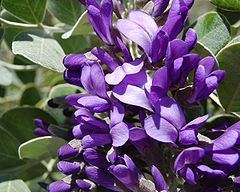Calia secundiflora
| Habit | tree
| |
|---|---|---|
| Height: | ⇕ | 30 ft"ft" can not be assigned to a declared number type with value 30. |
| Width: | ⇔ | 15 ft"ft" can not be assigned to a declared number type with value 15. |
| Lifespan: | ⌛ | perennial |
| Poisonous: | ☠ | all parts |
| Bloom: | ❀ | early spring, mid spring, late spring |
| Exposure: | ☼ | sun |
|---|---|---|
| Features: | ✓ | evergreen, flowers |
| USDA Zones: | 8 to 11 | |
| Flower features: | ❀ | blue, purple |
|
Fabaceae > |
Calia > |
Calia secundiflora is a species of flowering shrub or small tree in the pea family, Fabaceae,[1] that is native to the southwestern United States (Texas, New Mexico) and Mexico (Chihuahua and Coahuila south to Hidalgo, Puebla and Querétaro).[2] Common names include Texas Mountain Laurel, Texas Mescalbean, Frijolito, and Frijolillo.[1] It is an often-misunderstood plant, frequently confused with the Agave species used to make mezcal, as well as with Peyote (Lophophora williamsii), which contains mescaline.[3]
It is well-adapted to arid and semi-arid habitats but is most common in riparian zones.[1]
An evergreen, its leaves are pinnately-compound, with small, roughly spatulate leaflets; the leaflets are rather thick, and waxy to the touch Never tall, and rarely having a straight trunk, its bark is smooth in all but the oldest specimens.[4] It grows slowly to a height of 15 ft m and a crown diameter of 10 ft m .[5]
Extremely fragrant purple flowers, resembling the smell of grape soda, are produced in large clusters in March and April. They are followed by 4 in cm pods containing deep orange seeds.[5]
C. secundiflora is a popular ornamental plant due to its showy flowers and orange seeds. The reddish wood it produces is potentially useful, but as yet has little commercial value.
Further adding to this is the fact that the beans were in fact once used by some native American tribes as a hallucinogen, before being supplanted by peyote. This plant does not contain any mescaline, however; all parts of it are highly poisonous, due to the principle alkaloid cytisine, which is chemically related to nicotine.
Read about Calia secundiflora in the Standard Cyclopedia of Horticulture
|
|---|
|
Sophora secundiflora, Lag. Small tree, 35 ft. high, with short, slender trunk and upright branches forming a narrow head or shrubby: lvs. 4-6 in. long; lfts. 7-9, elliptic or obovate-oblong to oblong, rounded or emarginate at the apex, cuneate at the base, silky- pubescent while young, dark yellowish green above, 1-2 1/2 in. long: fls. violet-blue, the standard marked near the base with a few dark spots, very fragrant, about 1 in. long, in 1-sided racemes 2-3 in. long: pod white-tomentose, terete, 1-7 in. long, 1/2 – 3/4 in. thick; seed bright scarlet. Spring. Texas to New Mex.— On account of its handsome fragrant fls., to be recommended for planting South. CH
|
Cultivation
Propagation
Pests and diseases
Varieties
Gallery
References
- ↑ 1.0 1.1 1.2 Sophora secundiflora
- ↑ Cite error: Invalid
<ref>tag; no text was provided for refs namedGRIN - ↑ Mescal Bean & The Unrelated Peyote Cactus
- ↑ Sophora secundiflora Texas mountain laurel
- ↑ 5.0 5.1 Native Plants for Southwestern Landscapes
External links
- w:Calia secundiflora. Some of the material on this page may be from Wikipedia, under the Creative Commons license.
- Calia secundiflora QR Code (Size 50, 100, 200, 500)



